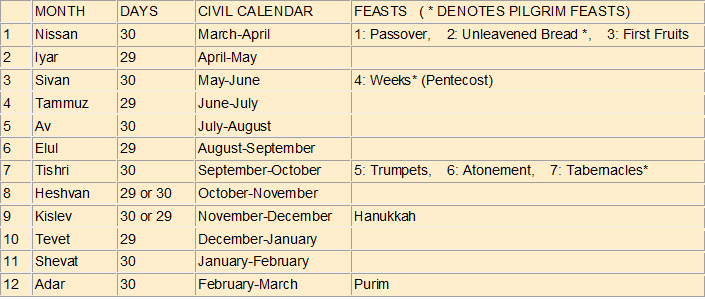Summary
The Book of Leviticus lists seven mandated annual “feasts of the LORD”, sometimes also referred to as Israel’s festivals. The first feast (Passover) starts in the month of Nissan (March-April) and the seventh feast (Tabernacles) occurs in the month of Tishri (September-October). Some of these festivals are to be held as “statutes for ever”, throughout all generations for all time, as in The Feast of Tabernacles. So this feast is mentioned in the Millennial age (Zech 14.16-19).
God’s seven annual feasts are relevant to both Jew and Gentile today. They show, prophetically, God’s complete plan concerning the coming of the Messiah, the redemption of mankind, judgement and the establishment of the Kingdom of God on earth. The first four feasts have been fulfilled: Passover, Unleavened Bread, First Fruits and the Feast of Weeks or Pentecost (the birth of the church). The last three feasts (Trumpets, Day of Atonement and Tabernacles) relate to the future.
Jewish Festivals are Feasts of the LORD

Jewish festivals – Feasts of the LORD
God told Moses to instruct the people of Israel in the way of holy feasts (Lev 23). Each feast was to be a holy convocation, meaning that, in each case, the people of Israel were to set apart an appointed time to Elohim (God) in order to read and understand His laws and then apply them in their lives. So these Jewish festivals were really feasts of the LORD (Lev 23.2) – God’s feasts – although today they are also called ‘Israel’s festivals’. Leviticus 23 lists seven mandated feasts or holy convocations (* denotes the three major feasts for which all males of Israel were required to travel to the Temple in Jerusalem):
- 1. Pesach (Passover), Mar-Apr
- 2. Feast of Unleavened Bread*, Mar-Apr
- 3. Feast of First Fruits, Mar-Apr, May-June
- 4. Feast of Weeks* (Shavuot or Pentecost), May-June
- 5. Feast of Trumpets (Rosh Hashanah), Sept-Oct
- 6. Yom Kippur (Day of Atonement), Sept-Oct
- 7. Feast of Tabernacles* (Sukkot or Feast of Booths), Sept-Oct
Some of these Jewish festivals are to be held as ‘statutes for ever’, throughout all generations for all time. The Feast of Tabernacles is a statute for ever (Lev 23.41) and goes on into the Millennial Age.
The Hebrew Calendar
These feasts or holy convocations are held during certain months of the Hebrew calendar, which starts with the first month of the year, Nissan (March-April) and ends with the 12th month of the year, Adar (February-March), link. However, the Jewish New Year Rosh Hashanah (‘head of the year’) is in Tishri, the seventh month, and that is when the year number is increased. Each month begins with a new moon (a thin crescent), growing to a full moon in the middle of the month and waning towards the end of the month (a cycle of approximately 29.5 days), see calendar. In addition to the seven feasts in Leviticus, Jews also hold the feasts of “Purim” and “Chanukkah (Hanukkah)”.

Hebrew Calendar and the Seven Annual Feasts
God’s Feasts are a Timeline for Mankind
God’s seven annual feasts are relevant to both Jew and Gentile today. They show, prophetically, God’s complete plan concerning the coming of the Messiah, the redemption of mankind, judgement and the establishment of the Kingdom of God on earth (recall that seven in scripture is the number of ‘completion’). The first four feasts have been fulfilled: Passover, Unleavened Bread, First Fruits and the Feast of Weeks or Pentecost (the birth of the church). The last three feasts (Trumpets, Day of Atonement and Tabernacles) are future, but soon to be fulfilled. Between the first four feasts and last three feasts we have the so-called ‘church age’ or ‘age of grace’, which many believe is rapidly drawing to a close, link. The Feast of Tabernacles takes mankind into the Millennial Age.
The Sabbaths – God’s ‘Sevens’
God’s Sabbaths distinguish God’s people, the nation of Israel from the Gentile nations. Not only do they give essential relief and rest for man and his environment, but they are also a perpetual sign of a special relationship between God and His people. Keeping Shabbat (Hebrew for the weekly Sabbath) is a sign of God’s people:
My Sabbaths are a sign between Me and you … that you may know that I am the LORD who sanctifies you … it is a sign between Me and the children of Israel forever (Exod 31.13,17)
… six days shall work be done: but the seventh day is the Sabbath of rest, an holy convocation; you shall do no work therein (Lev 23.3)
‘Seven’ is God’s number of perfection or completion and God’s Sabbaths go in ‘sevens’, marking the end of a 7-day week or the end of a 7-year cycle. So Saturday, the seventh day of the week, is God’s rest day for Israel. It is taken seriously, and with the sound of the Shabbat horn, link, a peace and silence descends on Israel’s cities each Friday afternoon as traffic slows down. Most Israeli’s spend Shabbat together with family and friends, and devout Israeli’s spend the day with festive family meals and attend the synagogue. In Jewish neighbourhoods the smell of chicken soup fills the air!
The seven annual biblical feasts are sometimes referred to as ‘high Sabbaths’, link, but they do not necessarily occur on a weekly Sabbath. For example, consider Nissan 15, the first day of the Feast of Unleavened Bread. This was a holy convocation or Sabbath (Lev 23.6,7). Many take Jesus’ crucifixion to be on Nissan 14, 30 AD, a Thursday, link, link, link, link. So Nissan 15 would be a Friday and not the weekly Sabbath. This could explain why Jesus’ body was taken down off the cross before Nissan 15, since that particular Sabbath was a high or special Sabbath (Jn 19.31). Traditional Judaism also recognizes special Sabbaths in Spring, Summer, Autumn and Winter, link.
The Land (Agricultural) Sabbaths – Rest for the Land
As soon as Israel entered the Promised Land, God instructed them to give the land a Sabbath rest every seven years:
The seventh year you shall let it rest and lie fallow (Exod 23.11)
… in the seventh year there shall be a Sabbath of solemn rest for the land (Lev 25.4)
During the seventh year all agricultural work like sowing, pruning and harvesting was prohibited, and it was a time for Israel to rely upon the provision of God. God’s detailed provision for this is described in Leviticus – God’s ‘guidebook’ for Israel:
If you say ‘What shall we eat in the seventh year’ … then I will command My blessing on you in the sixth year, and it will bring forth produce enough for three years (Lev 25.20,21)
So Israel would have enough to eat during planting in the eighth year. Today this applies to all Jewish owned agriculture in Israel, and keeping the ‘Shmita year’ or agricultural Sabbath is taken seriously by Jewish farmers even though it often brings them economic stress, link. But some who keep the agricultural Sabbath have found blessings: “More rain had fallen and the barley had come back to life and was growing … (and) sheep have given birth to 30% more lambs”, link.
The Shemittah (Shmita) Sabbaths – Release of Debt
Besides the weekly Sabbaths, another sign of God’s people is the release of debts at the end of every seven years:
At the end of every seven years you shall grant a release (remission) of debts (Deut 15.1)
In other words, creditors release others from anything they owe (Deut 15.2). This is the financial equivalent of the Sabbath year for land owned by Jews. The English word release (which is used four times in Deut 15.1,2) is a translation of the Hebrew ‘Shemittah’, meaning ‘remission of debt’ (or ‘suspension of labour’ as in Exod 21.2), link. The release of land and debt every seven years was God’s way of demonstrating to Israel that all they owned (in city and country) was from Him and that they were ultimately dependent upon Him. The seventh year was meant to be one of spiritual reflection.
The year 5775 after Creation, which ran from 25-09-2014, through to 13-09-2015 was a Shemittah year, link, link.
Are Shemittah (Shmita) Years Significant for Gentile Nations?
Shemittah observance, like the rest of God’s commandments, was to be followed and God warned Israel of the consequences of not following His commandments:
I will scatter you among the nations … your land shall be desolate and your cities waste. Then the land shall rest and enjoy its Sabbaths (Lev 26:33,34)
Cursed you shall be in the city and cursed shall you be in the country (Deut 28.16)

Does Israel’s Shemittah apply to Western nations today?
History bears this out. Because Israel did not observe the Shemittah and God’s other commandments, God sent the whole nation into captivity. The scattering of the northern kingdom was complete around 722 BC, and the exile of the southern kingdom (Judah and Jerusalem) to Babylon was complete in 586 BC. Jerusalem and the temple were destroyed and the nation ceased to be visible on the world scene.
Observance of the Shemittah (release of debt) was of course given to Israel and not specifically to the Gentile nations. But some ask, ‘Does the principle also apply to Gentile nations today?’ Jonathan Cahn, a messianic Jewish Rabbi and pastor, has proposed that the Shemittah can have implications to Gentile nations today! It is proposed that those Gentile nations who have once held to biblical truth, but now are rejecting it are in grave danger of God’s judgement. The morally and spiritually decadent western nations of America, Britain, Europe and Australia come to mind. More on this at Does God Judge Nations Today?.
Whilst Cahn’s thesis is challenged (see The Bearean Call), it is difficult to see how God can apply one rule to rebellious Israel and another to rebellious Gentile nations. Surely, as for Israel, these nations can expect financial and sociological collapse and great humbling because they reject the God of Israel and His word. Certainly many Shemittah year events in the 20th century, such as the destruction of the World Trade Center in 2001 and the 2008 Wall Street crash suggest this is true. More at Shemitah Year Events.
Summary of the Seven Biblical Feasts
1. Pesach (Passover)
The first of the seven mandated feasts. In the days of the Temple the Passover lambs were sacrificed in the afternoon of Nissan 14 (Lev 23.5) and the Passover itself commenced on Nissan 15. The lamb was roasted whole (no bone was to be broken) and eaten with unleavened bread (having no yeast or leaven, which is symbolic of sin in the scriptures) and bitter herbs. This recalls the night when God ‘passed over’ the homes of the Israelites because of the blood of the lamb (Exod 12.13) and the setting free of the Israelites in Egypt from the bitterness of slavery. Jesus regularly observed the Passover by going to Jerusalem with his disciples.
Today the Passover meal or Seder is traditionally eaten around sundown of Nissan 14 and into the early hours of Nissan 15. For believers in Christ it symbolizes the freedom they receive from bondage to sin when they accept forgiveness through the shedding of Christ’s blood on the cross. Jesus, who died without a bone being broken, is the believer’s Passover Lamb (Jn 8.36).
2. Feast of Unleavened Bread
The Feast of Unleavened Bread is closely linked to Passover and follows the next night after the Passover, on the 15th day of Nissan (Lev 23.6). The feast lasts seven days (15-21 Nissan) or eight days when Passover is included, and the first and last days are Sabbaths (Lev 23.7,8). So for example, ‘Passover 2018’ was celebrated from March 30 to April 7. During the feast only unleavened bread is eaten. This reminds Jews of the time when they came out of Egypt in haste, with no time for the leaven to make it rise (Deut 16.3). Leaven is a symbol of spreading sin, since just one spore of yeast spreads throughout the dough and rising bread is actually a natural process of decay. Yeast sours bread and rots fruit for example.
Today, the unleavened bread points to Jesus who was without sin, a lamb without blemish (1 Pet 1.19). Jesus also used leaven to illustrate how the kingdom of heaven starts from small beginnings (Mat 13.33).
3. Feast of First Fruits
This follows in April after the Feasts of Passover and Unleavened Bread and it is a ‘statute forever’. It looked to the reaping of the harvest that God promised Israel as they were entering the Promised Land, the first fruits being the first part of the harvest. The priest used to ‘wave the sheaf of the first fruits before the Lord on the day after the Sabbath’ (Lev 23.11). Orthodox Judaism takes this to be the day following the first High Sabbath of the Feast of Unleavened Bread, that is, Nissan 16 (the Sadducees took it to be the day after the weekly Sabbath, or Nissan 17), link. For believers, Jesus is the first fruit, being the first to rise from the dead, never to die again. He is the promise of eternal life to all who believe:
“Now Christ is risen from the dead, and has become the first fruits of those who have fallen asleep” (1 Cor 15.20)
4. Feast of Weeks (Shavu’ot or Pentecost)
This feast is named after the instruction to ‘count … from the day after the Sabbath … seven Sabbaths’ (Lev 23:15). This implies count 50 days from the Sabbath. The Sabbath here is traditionally taken to be Nissan 15, the special Sabbath of the Feast of Unleavened Bread, link, so we count 50 days starting with Nissan 16 as day 1. This brings us to a Sunday in the month of Sivan (May/June), (see calendar). So Shavuot, the Feast of Weeks, always falls on a Sunday, link. Why 50 days? It is a commemoration of the giving of the Law (the Torah) at Sinai 50 days after crossing the Red Sea. For believers in Christ, Pentecost (meaning ’50 days’) celebrates the giving of the Holy Spirit (Acts 2). So the Jewish Shavu’ot is a type of the Christian Pentecost; both are concerned with the giving of God’s Law, but today God’s Law is written on the hearts of all who believe in Christ (Rom 2.15).
5. Feast of Trumpets
This is a Sabbath rest on the first day of the the seventh month (Tishri, September/October). It is a time for the ‘blowing of trumpets’ (Lev 23.23-25, Num 29.1,2), a time when the shofar, a ram’s-horn trumpet, is sounded in synagogues. Tishri 1 is observed by the public reading of the scriptures, link, a time for reminding Jews of the coming of their King (Isa 60-61), and a time for reminding Messianic Jews that Yeshua will start His return at the last trumpet. This is one of three feasts in the seventh month completing the yearly cycle of sacrifices and harvests, and we note that the seventh month is the number of completion in scripture.
Today, Tishri 1-2 is celebrated as the Jewish New Year or Rosh Hashanah (‘Head of the Year’) which relates primarily to the agricultural cycle and the beginning of a new harvest year. For believers, the sounding of trumpets foresees the trumpet of God at the first resurrection, when they are raised to meet Christ in the air at the end of this age (1 Thes 4.16).
6. Yom Kippur or Day of Atonement
Since the 10 days of Rosh Hashanah span Yom Kippur they are called the ‘days of awe,’ when individuals consider their sins before God and enter into a period of repentance. Yom Kippur itself occurs on the 10th day of Tishri and is a solemn time of rest, prayer and fasting – a time of sincere reflection on the state of one’s relationship or ‘at-one-ment’ with God. It is hoped that such prayer and fasting will lead to forgiveness for offenses committed against God, and in the ten days leading up to Yom Kippur Jews are encouraged to seek out anyone they might have offended and to sincerely request forgiveness.
Yom Kippur pictures the Judgement Day when the Messiah returns to judge the world. So in modern Israel, nothing moves on Yom Kippur! Historically the High Priest entered the Holy of Holies to offer atonement for himself and the people. Today, Christians look to the atoning work of Christ on the cross:
“Jesus cried out with a loud voice, and breathed His last. Then the veil of the temple was torn in two from top to bottom.”(Mk 15.37,38)
Biblically, the Day of Atonement is a ‘statute for ever’ (Lev 23.31) and so it extends into the Millennium (Zech 14.21). Whilst Christ’s sacrifice was for all and for all time, it appears that sinful man living close to Christ still needs to recognise his sinful nature, even in the Millennium!
Many link the Day of Atonement to the binding of Satan in Rev 20.1-3, link. This can be seen in the ceremony of the two goats (Lev 16.8-10). The first of the two goats is killed (a parallel with Jesus death) whilst the second goat, the Azazel goat, is paralleled with Satan since it is seen as unclean (bound with sin) and sent into the wilderness (Lev 16.20-22,26).
The Yom Kippur War: In October 1973 an Arab coalition led by Egypt and Syria launched a joint surprise attack against Israel whilst many Israelis were at home honoring Yom Kippur. So Israel was unprepared and suffered many losses, but through God’s miracles the invasion was defeated after just four weeks, link. God honored the keeping of His special day.
7. Feast of Tabernacles (Sukkot)
Also in the seventh month or Tishri, starting on the 15th day and lasting for seven days is the Feast of Tabernacles. The fist day of Sukkot is a Sabbath rest (Lev 23.35). Sukkot means ‘booths’ and it commemorates the time when Israel lived in tents or booths as they came out if Egypt. It commemorates the transition of the Jewish people from bondage in Egypt to sovereignty in the Land of Israel; from nomadic life in the desert to permanence in the Promised Land; from oblivion to deliverance. It is a feast of joy and celebration following the harvest. Jesus made His great proclamation in the temple during Sukkot (Jn 7.37), foreseeing the end time harvest of believers (Jew and Gentile):
“So He who sat on the cloud thrust in His sickle on the earth, and the harvest was reaped.” (Rev 14.16)
So Sukkot foresees the in-gathering of the saints and the Millennial reign of Christ, the Messiah. It also embraces the Great White Throne judgement at the close of the Millennium (Rev.20:5-14). Sukkot is one of the feasts that is a ‘statute for ever’, and so during the Millennial age the nations of the earth go up to worship Christ the King in Jerusalem, and to keep the Feast of Tabernacles (Zech 14.16).
The symbolism goes even further. Note that the week of Sukkot is followed by an eighth day (Lev 23.36). The 8th day (also a Sabbath rest) has great significance. Number 8 symbolizes the start of something new – a new beginning. It foresees the new heavens and new earth and the New Jerusalem (Isa 65.17), link.
Feasts and Fasts in the Millennium
Chapters 40-48 of the prophet Ezekiel are often ignored due to uncertainty of interpretation. But if we read them in the light of the coming Millennial Age they provide a wealth of detail about future Israel. In particular, Ezek 45.18-25 describes Millennial feasts: we see the Passover in Ezek 45.21 and the Feast of Tabernacles in Ezek 45.25 (also Zech 14.16). The fact that these are future feasts (after Christ’s return) is confirmed by the prophet Zechariah:
Everyone who is left of all the nations which came against Jerusalem shall go up from year to year … to keep the Feast of Tabernacles (Zech 14.16)
What about Fasting?
During the present age the Jewish calendar contains several fast days, most of them commemorating various historic events, link, link. Consider just four of these, which are identified in Zech 8.19 as fasts of the ‘fourth’, ‘fifth’, ‘seventh’ and ‘tenth’ months respectively:
- Fast of the fourth month: Fast of Tammuz – commemorating the conquest of Jerusalem by Nebuchadnezzar in the fourth month (2 Kings 25.3). Also commemorates the breaking of the two tables of the law, link
- Fast of the fifth month: Fast of Tishah – commemorating the return of the spies sent to explore Canaan, and the consequent punishment of forty years in the wilderness (Num 13,14). Also remembers the destruction of the first (2 Kings 25.8, Zech 7.3) and second temples
- Fast of the seventh month: Fast of Gedaliah – commemorating the murder of the Judean governor Gedaliah, a man appointed to help the poorer Jews left in Judea during the exile, link (Zech 7.5)
- Fast of the tenth month: Fast of Tevet – commemorating the fall of Jerusalem under Nebuchadnezzar (Jer 52.4)
Historically, these fasts were times of weeping and mourning and their festivals had been turned into mourning (Zech 7.3-5). But in the Millennial Age the LORD replaces them with times of joy and feasting:
(These fasts) … shall be joy and gladness and cheerful feasts for the house of Judah (Zech 8.19)
The former miseries will be forgotten in the presence of the blessings showered upon them in the Millennium!


































i find the article very useful in my finding
Thanks a lot